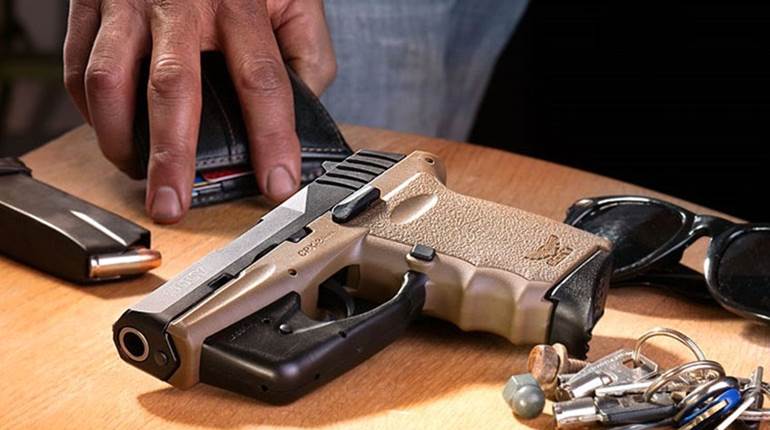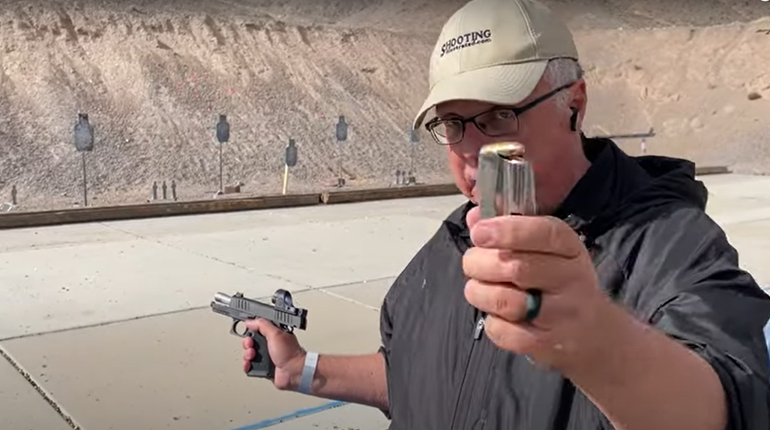
Some folks take their plinking seriously. It's not enough to just have any old wood-stocked .22 Long Rifle semi-auto in their hands. They're ready to take advantage of the growing selection of Tactical .22s, also known as Modern Sporting .22 Rifles, now available on the market. These .22s are near carbon copies of full-size combat rifles. However, they have been modified to be less expensive to buy and to shoot. To flesh out this growing field of tactical can tappers, ISSC Austria has stepped forward with its contribution—the MK22.
For fans of the FN-SCAR battle rifle, the MK22 should look very familiar. Along with the FN-style stock and receiver outline, the MK22 has many of the same features as the rifle that inspired it. The receiver is an all-metal construction, with a Picatinny-style rail system on all receiver surfaces. This includes a barrel placement for attaching FN sights. The mussle of the precision match, 16-inch barrel is cut with a 1:28 thread to accept various muzzle breaks and flash hiders.
The three-position shoulder stock is adjustable for length, features a sling buckle mount and it has a two-position cheek rest that adjusts for height. The stock is fitted with a metal hinge to fold to the side with a polymer frame hook to lock the stock in the folded position for tactical training exercises. Both 10- and 22-round magazines are available.
The adjustable front and rear rifle sights can be folded down to make room for a scope. When in the down position, the sights become a three-dot pistol system. The three-dots are not terribly useful on this gun, but an interesting idea nonetheless. The charging handle is part of the patent-pending Universal Charging Adaption System (UCAS), which allows the handle to be moved to three locations on the right or left side of the gun. The hollow grip is fitted with a removable base plate so it can be used for storage. The MK22 is available in a black or tan finish.
The one thing missing from this rifle is a useful set of cleaning instructions. Maintenance is important for any firearm, but semi-auto .22s are notorious for getting exceptionally grimy. The instructions don’t allow for complete field stripping of the rifle, but they also warn against the spray-on solvents that would be useful when cleaning a partially stripped rifle. So shooters are left to figure something out on their own.
I took advantage of the accessory rail system to dress up the gun a bit. The lower rail provided an ideal location for the Streamlight TLR-1. The rail had plenty of room to move this compact, powerful flashlight back and forth to find the ideal location operation. This rifle also provided good opportunity to take LaserLyte's K-15T laser for a test drive. You may not see the need for a cutting-edge green laser for knocking over pop cans, but if you’re using the MK22 as an affordable stand-in for an FN, then testing a laser makes sense. For long range work, an Alpen Optics Model 4031 3-9 x 42 scope was affixed to the top rail with quick release rings to provide a crisp, clear view of the targets. However, even with 1-inch high rings, there was not enough room to leave the collapsed rear iron sight attached, so the rear sight was removed when the scope was in use.
At the Range
The price tag on the ISSC MK22 places it in the center of the price range for the current set of tactical .22s on the market, but the dollars spent are reflected in the heft and balance provided by the all-steel barrel and aluminum receiver. Some companies, in an effort to make their tactical .22s more affordable, have used too much polymer. The guns feel like they should be filled with water from a garden hose rather than loaded with ammunition. But shouldering and shooting the MK22 feels like you are running a "real" gun. The recoil of the MK22 is feather light, as is to be expected. The trigger is smooth, gauging out at 4-pounds, 12-ounces, with some creep after the firing pin is released. Formal accuracy testing was conducted from a bench rest using five consecutive, five-shot groups with targets set out to 100 yards.
The overall accuracy results at 100 yards were not awe-inspiring, but they were relatively consistent. The best single group of 2.75 inches was produced by Winchester's new M22 40-grain black copper-plated round nose ammunition. The M22 also produced the best average group set with a measurement of 3.2 inches. The next best performer was CCI's new AR Tactical 40-grain copper-plated round nose with a best single group of 3 inches, and a five-group average of 3.35 inches. Third place goes to CCI Velocitor 40-grain copper-plated hollow points, with a best group of 3.5 inches, and an average of 4.1 inches. These three test loads ran without any failures during the formal testing and during the extended informal testing.
The MK22's accuracy was markedly better at 50 yards. During informal testing at this range, using a full spread of high quality and inexpensive bulk rounds, results hovered around the 2-inch mark, with ragged less-than-an-inch holes produced with quality ammunition. This rifle has a very low ammunition fussiness factor, running with almost no problems across several varieties of ammunition fired. Three malfunctions occurred during this portion of the testing. One was a failure to eject resulting in the need to pry the spent case out of the chamber, followed by two stove-pipes. The failures all occurred with the same brand of affordably priced bulk ammunition. Since no other malfunctions occurred in the course of firing hundreds of rounds, the problems can be written off to that particular load.
Fifty yards turned out to be an ideal range to work with the K-15T laser. At this range, even in bright, late-afternoon sunlight, the green dot was visible on the various targets used. As the afternoon wore on and the sun started to set, the dot just got brighter. This LaserLyte sight is easy to dial in and work with, and it looks pretty cool on the gun.
Final Thoughts
The greatest strength of this rifle is the flexibility of its possible applications. For an understudy to the full-throttle FN-SCAR, a customizable small game hunter or over-the-top plinker, the MK22 can do it all with panache. I've even heard folks suggest that the combat features of this rifle make it a candidate for a low-recoil self-defense option for the injured or elderly. With quality ammunition, and enough rounds fired with proper shot placement, it could do the trick. For those folks who take their .22s seriously, the MK22 is seriously fun to work with.
Manufacturer: ISSC Austria; issc-austria.com
Model: MK22 Rifle
Action: Semi-Auto
Caliber: .22 Long Rifle
Finish: Black or Tan Ti-Clad finish
Sights: Adjustable Rifle/ 3-Dot
Barrel Length: 16”
Overall Length: 36” (Stock Extended)
Width:2.81”
Weight:6.5 lbs.
Capacity:10 + 1, or 22+1 Rounds
Twist: 1:16” RH
Rifle Grooves: 6
Suggested Retail Price: $549.95






































